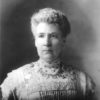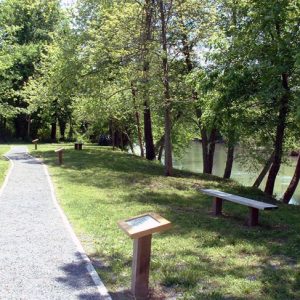calsfoundation@cals.org
Caddo Indian Memorial
The Caddo Indian Memorial is located on the site of a Native American burial ground on the outskirts of Norman (Montgomery County) on Arkansas Highway 8 East. Open year-round and free to the public, it contains the Elmo Clark Honor Path, which runs a quarter of a mile along the perimeter. This allows visitors easy access to the twenty-one signs that explain the culture and history of the Caddo Indians. The path runs parallel to the Caddo River and its tributary, Huddleston Creek, which form the southwestern and northwestern boundaries.
In October 1988, the city of Norman had begun excavation at this site for construction of a sewage treatment plant, but digging was stopped abruptly when bones and artifacts were discovered. Subsequent archaeological excavations by Dr. Ann Early of the Arkansas Archeological Survey found evidence of significant Caddo Indian occupation, dated AD 1250–1500. Two burials and a small cluster of residential features and artifacts—including two small incised ceramic jars, a large chert biface, and eight novaculite arrowpoints—were uncovered, indicating that Caddo Indians lived on this plot of ground. Earlier residential use of the site left the remains of a large circular house with a hearth and burned floor. Artifacts of the Archaic and Woodland Fourche Maline periods were also discovered. No further archaeological excavation took place, but stone spear or dart points made by the Dalton (circa 8500 BC) and Tom’s Brook (circa 4500 BC) cultures have been found in nearby archaeological sites, indicating that mobile hunter-gatherers passed through this area toward the end of the last ice age (Paleoindian period).
Following the wishes of the Caddo Indian Nation, headquartered in Binger, Oklahoma, the city of Norman relocated the sewage plant, and the remains and artifacts were reburied; in April 1989, Chairman Elmo Clark of the Caddo Nation led a religious ceremony on the grounds. The burial ground was then covered with a “hard to dig” material to thwart future pilfering and pot hunting. Grass was planted, and a wooden fence was added to keep vehicles off the premises. The city maintained the area, but nothing indicated that the fence encompassed a sacred place.
In 2000, the Southern Montgomery County Development Council (SMCDC) received a grant from the Arkansas Humanities Council to create and display interpretive historical signage at the Caddo Indian Burial Ground. The signage was reviewed and edited, both historically and archaeologically, with the assistance of Caddo Indian scholars Dr. Cecile Elkins Carter of the University of Oklahoma, who is a member of the Caddo Indian Nation, and Arkansas archeologist Dr. Mary Beth Trubitt of Henderson State University.
SMCDC funded and provided the labor to construct a pathway, which was made of natural materials (as requested by the Caddo Nation). The path and the two-color, reverse-screen printed signs on Lexan were in place the summer of 2002. The twenty-one signs are grouped in five clusters, depicting the life and culture of the Caddo and their ancestors from earliest known records. The information center at the entrance provides an archaeological analysis of the burial ground. The signage groupings include the following: a history of the inhabitants, a description of local environment and resources, the subsistence practices of the Caddo, and cultural and community structure of the Caddo. The three-foot-wide path incorporates a street base that is covered with crushed shale fines and stabilized with an organic binding agent. A secondary path skirts Huddleston Creek. Benches are spaced so visitors can pause and enjoy the experience. Wildflowers grow in a fifty-foot diameter garden in the center of the burial site.
For additional information:
Arbanas, Michael. “Ancestors to Rebury Tribesmen.” Arkansas Gazette. April 2, 1989, pp. 1B, 4B.
———. “Old Bones Cause Stir at Norman.” Arkansas Gazette. October 30, 1988, pp. 1B, 6B.
———. “Sewage Plant to Be Moved; Burial Site Safe.” Arkansas Gazette. January 25, 1989, p. 1B.
Carter, Cecile Elkins. Caddo Indians: Where We Come From. Norman: University of Oklahoma Press, 1995.
Early, Ann M., et al, Standridge: Caddoan Settlement in a Mountain Environment. Research Series 29. Fayetteville: Arkansas Archeological Survey, 1988.
Schambach, Frank. Crossroads of the Past: 12,000 Years of Indian Life in Arkansas. Popular Series 2. Fayetteville: Arkansas Archeological Survey, 1990.
Truitt, Mary Beth, and Ann M. Early. “The Caddoan Indian Burial Ground (3MN386), Norman, Arkansas.” Caddoan Archeology Journal 13, no. 2 (2003): 13–24.
Mary B. Lysobey
Montgomery County Historical Society
 Historic Preservation
Historic Preservation Caddo Indian Memorial
Caddo Indian Memorial 




Comments
No comments on this entry yet.